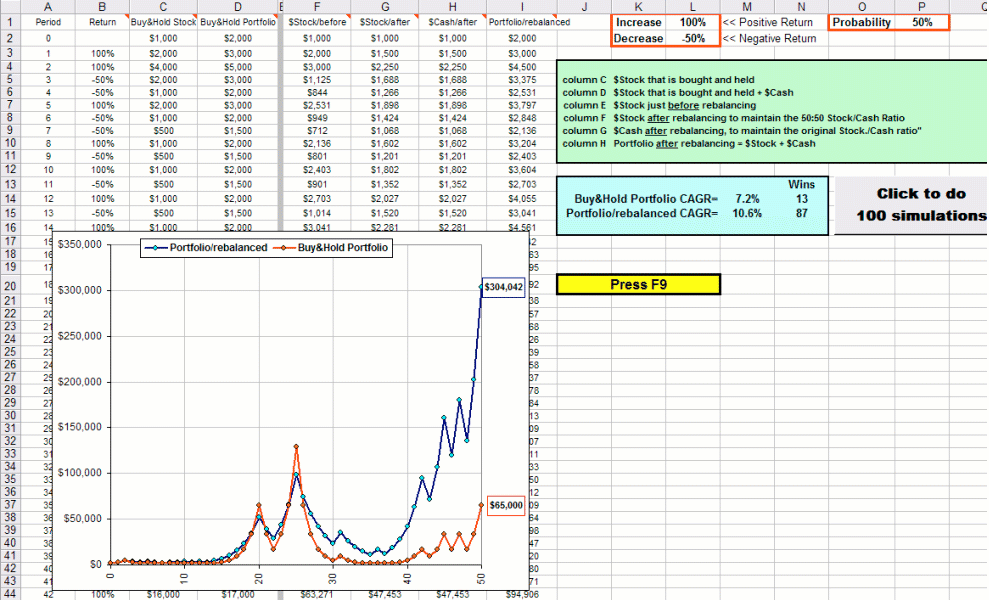| Volatility Pumping |
So I get this e-mail asking about volatility pumping and ...
>And, as usual, you've never heard of it before, right?
Uh ... yeah. Anyway, it goes like this:
Scenario #1:
- A stock has an annual return of either 100% or -50%, with equal probability ... that is, a Gain Factor of 2 or 0.5.
- The succession of annual returns are then R1%, R2%, R3% etc. where the Rs are either 1.0 or -0.5 ... meaning +100% or -50% return.
- After N years, you'd expect N/2 returns of 100% and N/2 returns of -50%: that is, Gain Factors of 2 and 0.5.
- You'd then expect that $1 invested in this stock would end up (after N years) with the value: 2N/2 (0.5)N/2 = $1.
Wait. I haven't finished.
Now consider this:
Scenario #2:
- You start with $1 invested in that Stock (described above) and $1 in Cash for an initial portoflio of $2.
- At the end of each year you rebalance so that you have equal dollar amounts in the Stock and in Cash.
If the Stock doubles in value, you sell some Stock to put into Cash to maintain the 50:50 Stock/Cash Ratio.
If the Stock halves in value, you buy more Stock with money from your Cash account to maintain the 50:50 Stock/Cash Ratio. - At the end of each year, after rebalancing, you have equal dollars in each of your Stock and Cash accounts.
Each year you start with equal amounts, say $A (after rebalancing), in each account.
Before rebalancing, if the Stock doubles by the end of the year, you'll have A + 2A = 3A in total for a Gain Factor of 3A / 2A = 1.5.
Before rebalancing, if the Stock halves, you'll have A + 0.5A = 1.5A in total for a Gain Factor of 1.5A / 2A = 0.75. - After rebalancing, you'll again have equal amounts in each account of, say, $B + $B.
- After N years you'd expect N/2 Gain Factors of 1.5 and N/2 Gain Factors of 0.75.
- You'd then expect that your initial $2 invested in this Stock/Cash portfolio would end up (after N years) with the value: 2(1.5)N/2 (0.75)N/2 = 2(1.125)N/2.
- That is, your Compound Annual Growth Factor would be: 1.1251/2 ... taking the Nth root of (1.125)N/2
- That's a Compound Annual Growth Rate of: CAGR = 1.1251/2 - 1 = 0.06 or 6%.
Yes ... make money by having two assets (Cash & Stock) each of which have an expected return of 0% ... just by rebalancing.
>Is that what you do?
No. I can't find a stock that has equal probabilities of doubling or halving. 
If you change the two possible returns from +100% and -50% to something else (more reasonable) and the probability of getting the first isn't 50% but something else, then ...
>Then you lose money, right?
Sometimes.
Here's a spreadsheet to play with. You can change the +100% and -50% and the probability of getting the former from 50% to something else.

Click the picture to download the spreadsheet.
Each time you press F9 you get a different set of returns.
You can also click a button to have the spreadsheet press F9 for you ... 100 times.
For example, if you get a 10% return 65% of the time, but a -20% return 35% of the time, then that's a horse of a different hue. 
Further, if you include trading fees for that rebalancing ritual ...